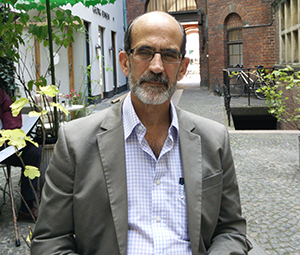It is with great sadness that we have to report the sudden death of Professor Henry Power.
Henry Power, described as a giant in his field, was closely associated to Wessex Institute of Technology, where he worked from 1991 to 2000.
He became Professor at the University of Nottingham with the Chair of Computational Fluid Dynamics in the Department of Mechanical Engineering.
Henry was born in Caracas, Venezuela, where he graduated from the Central University of Venezuela as a Civil Engineer, after which he studied at MIT.
Upon his return to Venezuela, he worked at the Central University, starting as a Research Fellow and becoming Professor in charge of the University’s Institute of Fluid Mechanics.
It was during that time that he met Carlos Brebbia, Director of WIT at an International Conference in Novo Hamburgo, Brazil, where, between swimming and cycling (both sports that he loved) they discussed the possible application of boundary elements to problems such as bubble mechanics. This led to Henry spending his sabbatical leave at Wessex Institute of Technology, where he stayed for nine years, becoming Head of its Advanced Computing Division.
He and his family lived on Campus, becoming part of the New Forest Community and remembered by all at WIT for being pleasant and cheerful in all circumstances. Henry was renowned for his love of his family, his tolerance and sense of humour. His commitment as a PhD supervisor provided outstanding research results.
In 2000 he joined the University of Nottingham’s Faculty of Engineering, where he established a long and distinguished career spanning 17 years.
Blessed with a brilliant mathematical mind, he always felt that there was no problem that could not be looked at from a numerical point of view. Professor Steve Pickering, Head of his Department at Nottingham, remembers him being “very passionate about his subject. He had a passion for trying to understand everything.”
Throughout his academic career in the UK, Henry taught many courses on advanced numerical techniques, among others. He continued to develop the pioneering Boundary Element Method and its industrial applications. His research covered many areas of applied mathematics and he had numerous collaborators around the world. An outstanding researcher, his mathematical ability was matched by his phenomenal work rate. He was exceptionally well versed in leading difficult areas of numerical modelling with the novel use of boundary element and other meshless techniques. During his stay at WIT he became an Editorial Board Member of the International Journal of Engineering Analysis with Boundary Elements, where he contributed with numerous papers and was renowned as one of the best reviewers.
Professor Luiz Wrobel, another close friend and collaborator from the time they were together at WIT, described Henry as “a very enthusiastic teacher and lecturer. Henry was a complete engineer because he understood the physics and the mathematics”.
Professor Carlos A. Brebbia, Director of Wessex Institute, which was where Henry started his career in the UK, thought of him as “one of the best supervisors we have had, always generous with his time and willing to help students and colleagues when necessary”. Carlos remembers with affection his family and how well they adapted to English life, rapidly becoming a major asset to WIT and the local community.
Henry was very much a family man. He is survived by his wife Beatriz, who teaches Spanish at Nottingham University, and his son Guillermo and daughter Coromoto.
Aside from work, Henry enjoyed taking his grandchildren cycling and watching them play. He loved walking and swimming every day and exercising in the gym.
His passing away is deeply regretted by the Boundary Element Community, which has decided to award him posthumously the prestigious George Green Medal during the forthcoming 40th International Conference on Boundary Elements (BEM/18), along with dedicating the recent special Journal issue to his memory.
The Medal is awarded annually to scientists who carried out original work on the practical applications of boundary element methods and further developed the pioneering ideas of George Green, the mathematical genius from Nottingham, who single-handedly set up the basis for the BEM as well as many other applications of fundamental importance in advanced numerical analysis.
The Award was established by the University of Mississippi at Oxford, USA, and the Wessex Institute of Technology and is supported by Elsevier.
Professor Carlos A. Brebbia, Director of the Wessex Institute, commented “Henry made many important contributions to his scientific field and helped to establish research groups all over the world. The George Green Medal is a fitting recognition of his professional life throughout which he strove to generate new knowledge which could be used by many researchers to solve a variety of engineering problems.
Acknowledgment is given to the official Obituary prepared by Nottingham University.

 Wessex Institute
Wessex Institute